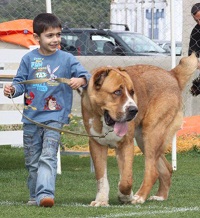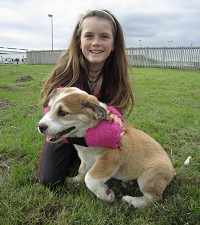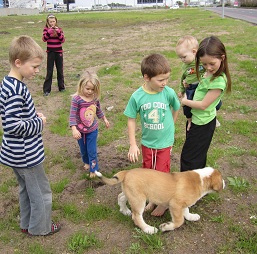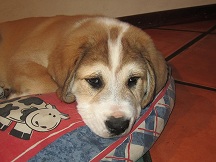HOME
Preschool Homeschooling
Dogs and Children
Tips for training dogs and children to get along well together.
We recently acquired a new puppy, which will soon grow to be a large guard dog. My husband wanted a dog that will be harsh with intruders but good with the children.
After much research, we have a Central Asian Ovtcharka (shepherd dog). The image below shows a full grown one.

Since this doggie will weigh more than me when he is full grown, we have to make sure that we train him properly while he is young, or else we will not be able to manage his sheer brute strength, even on a leash.
This led me to do quite a bit of reading up about dog behaviour and how to make sure a dog behaves well in the family. We can't have him snapping at the children or their little friends!
I realised how little most of us understand about dogs and I believe that many children especially are at risk because of this. The large majority of dog bite victims are young children.
Sadly, when incidents like dog bites happen, the dog is usually blamed, but actually, there are no bad dogs, only bad owners...and despite the saying, "You can't teach an old dog new tricks," according to the experts, dogs can be retrained to behave properly and not be a menace.
Unfortunately, euthanasia is the greatest cause of death among dogs. Unruly dogs are euthanased by their owners or taken to animal shelters where many are euthanased if they can't be re-homed...and all this could be avoided if people knew how to treat and train their dogs better.

In brief, what I have learned is that instinctively, dogs are pack animals who need a strong leader - a human leader in the case of a family pet.
If a pet dog does not know that he is at the bottom of the pack hierarchy, he may think he owns any human who is, in his mind, lower than him - and he might bite anyone to protect 'his' human, possibly even a family member.
So, a pet dog needs to be trained to understand that ALL humans are above him in status. There are various ways to do implement this, which any dog owner would be wise to learn.
Even small dogs are often aggressive and nasty as they have been elevated in their pack status, by ignorant humans who put them on their laps, on furniture and beds and allow the dog to dominate them in various ways.
To be your dog's leader
- Take your dog for a daily walk and train him to walk beside or better still, behind you on the leash. YOU lead him. He may NOT lead you. All children must be in front of the dog, even a baby in a stroller.
- Humans must always go through doorways before dogs and exit the property before dogs when out walking. On returning, again all humans go into entrances first.
- Humans eat first and dogs must be fed after them from their own bowls. They must be commanded to sit and wait calmly before being fed. No begging or feeding from the table.
- After the dog's meal, the bowl must be removed until the next feeding time again, so that the dog may not self-feed in between meals. In nature the pack leader determines when the other dogs may eat, so a good human leader will do this too.
- It is a good idea to feed the dog a short while after his walk as this is how dogs operate in nature. Food must be earned.
- When your child is responsible enough, you can teach her the correct way to feed the dog. This will re-inforce the child's status over the dog in the family pack.
- Don't allow dogs on furniture, unless at your command. The pack leader must have the best position and best bed, not the dog!
- Don't use a choke chain, rather use a harness. Research shows that choke chains are harmful to the dog's larynx, oesphagus and spinal chord and the pain actually exacerbates aggressive and unruly behaviour.
For more detailed explanations of the above principles and more, you can search the net for info on dog behaviour.
How to Introduce Children to Strange Dogs

What do you do when you go out walking and you see a strange dog come gambolling over towards your family, or you visit friends who have a dog?
Here are some tips for teaching your children safe and appropriate behaviour with dogs.
- NEVER leave children unsupervised with an unfamiliar dog, no matter how great the owner says the dog may be with children. If a child makes a mistake, the animal's instincts to protect itself may kick in ...and just a nip in the face could leave a child scarred for life. Its not worth the risk!
- Teach your children never to approach a strange dog. Rather allow the dog to come over and sniff them first. The child should stand still and be calm and avoid eye contact with the dog. This shows 'respect' in dog behaviour, whereas making eye contact may be seen as a challenge.
- Help your child to learn to identify a dog's mood by its body language. Is the dog wagging its tail and friendly, or is it raising its hair, lifting a lip to show its teeth or even growling in a menacing way?
- A child should not run from an unfriendly dog, but rather slowly back away, without making eye contact with the dog. If a child runs, the dog may give chase as if it were hunting a prey.
- A child should also not play with a dog that is over-excited. It may get rough and hurt the child.
- Tell your children that dogs don't like to be hugged around the neck. This shows dominance in dog behaviour and the dog may react and bite.
- Children should be taught never to tease a dog or hurt an animal in any way, such as pulling the ears or tail, poking the eyes or other sensitive places.
- Although a well-socialized family pet should not growl if a child comes near its food, children should always stay away from strange dogs when they are feeding or playing with their doggie-toys, as they may protect their food / toy by snapping or biting at the child.

- A child (or adult) should never allow a dog to run and jump on them or climb on top of them, even in play, as the dog will understand this as the child submitting and being lower in the pack status than the dog himself. Dogs must always be lower than humans in their pack hierarchy.
When you have a new puppy, like us, you have to educate yourself and then diligently train the whole pack - the kids as well as the dog! Its hard work but the rewards will be worth it when you have a disciplined and well-socialized pet.
|














New! Comments
Have your say! Leave a comment in the box below.